Francesc Lluís
Denoising of Photogrammetric Dummy Head Ear Point Clouds for Individual Head-Related Transfer Functions Computation
Aug 29, 2024



Abstract:Individual Head Related Transfer Functions (HRTFs), crucial for realistic virtual audio rendering, can be efficiently numerically computed on precise three-dimensional head and ear scans. While photogrammetry scanning is promising, it generally lacks in accuracy, leading to HRTFs showing significant perceptual deviation from reference data, owing to the scanning error mainly affecting the most occluded pinna structures. This papers analyses the use of Deep Neural Networks (DNNs) for denoising photogrammetric ear scans. Various DNNs, fine-tuned on pinna samples corrupted with modelled synthetic error mimicking that observed in photogrammetric dummy head ear scans, are tested and benchmarked against a classical denoising approach. One DNN is further modified and retrained to increase its denoising performance. The HRTFs computed on original and denoised scans are compared to those of a reference scan, showing that the best-performing DNN is capable of generally decreasing the deviation of photogrammetric dummy head HRTFs to levels obtained with accurately measured individual data. Correlation analysis between the geometrical metrics, computed on the scanned point clouds, and the related HRTFs is used to identify the most relevant metrics to assess the geometrical deviation between target and reference scans, in terms of the similarity of the HRTFs computed on them.
Direction Specific Ambisonics Source Separation with End-To-End Deep Learning
May 19, 2023



Abstract:Ambisonics is a scene-based spatial audio format that has several useful features compared to object-based formats, such as efficient whole scene rotation and versatility. However, it does not provide direct access to the individual source signals, so that these have to be separated from the mixture when required. Typically, this is done with linear spherical harmonics (SH) beamforming. In this paper, we explore deep-learning-based source separation on static Ambisonics mixtures. In contrast to most source separation approaches, which separate a fixed number of sources of specific sound types, we focus on separating arbitrary sound from specific directions. Specifically, we propose three operating modes that combine a source separation neural network with SH beamforming: refinement, implicit, and mixed mode. We show that a neural network can implicitly associate conditioning directions with the spatial information contained in the Ambisonics scene to extract specific sources. We evaluate the performance of the three proposed approaches and compare them to SH beamforming on musical mixtures generated with the musdb18 dataset, as well as with mixtures generated with the FUSS dataset for universal source separation, under both anechoic and room conditions. Results show that the proposed approaches offer improved separation performance and spatial selectivity compared to conventional SH beamforming.
Points2Sound: From mono to binaural audio using 3D point cloud scenes
Apr 26, 2021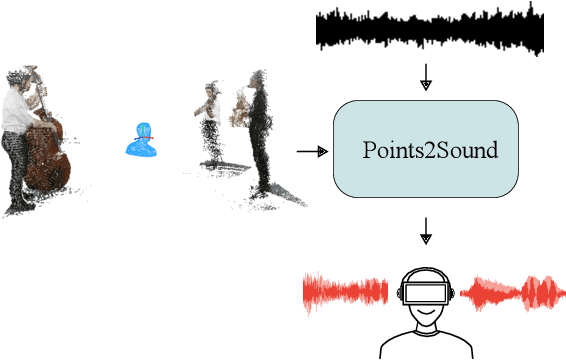

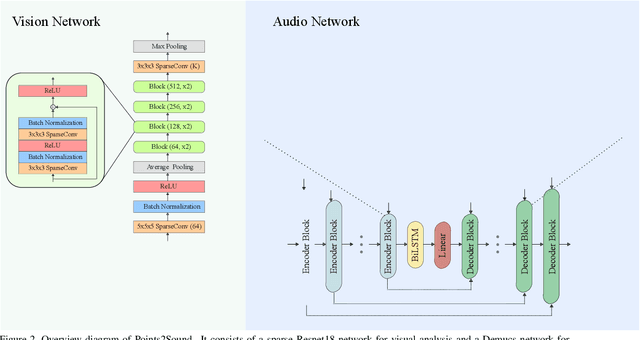
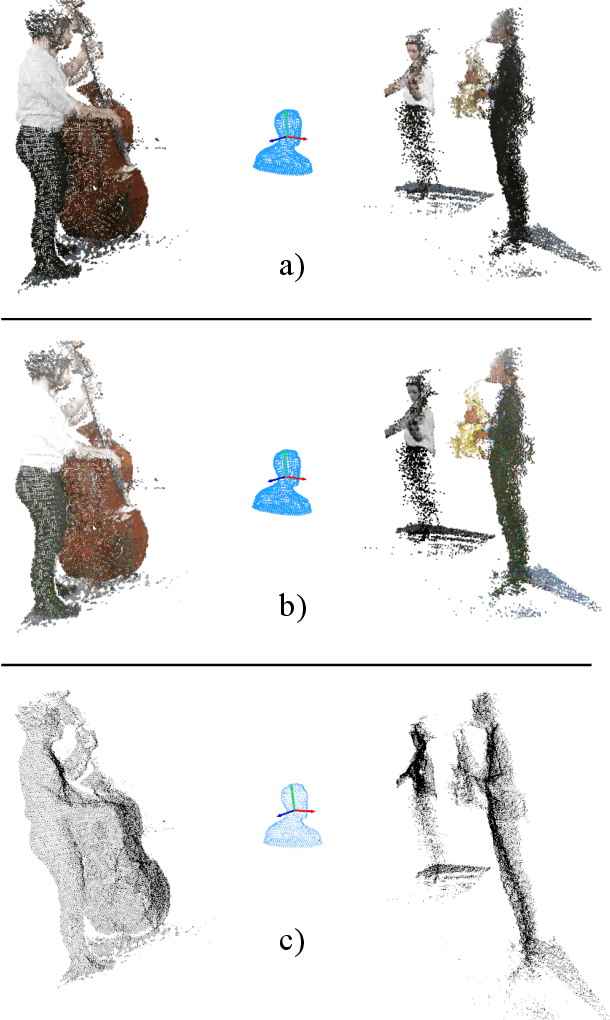
Abstract:Binaural sound that matches the visual counterpart is crucial to bring meaningful and immersive experiences to people in augmented reality (AR) and virtual reality (VR) applications. Recent works have shown the possibility to generate binaural audio from mono using 2D visual information as guidance. Using 3D visual information may allow for a more accurate representation of a virtual audio scene for VR/AR applications. This paper proposes Points2Sound, a multi-modal deep learning model which generates a binaural version from mono audio using 3D point cloud scenes. Specifically, Points2Sound consist of a vision network which extracts visual features from the point cloud scene to condition an audio network, which operates in the waveform domain, to synthesize the binaural version. Both quantitative and perceptual evaluations indicate that our proposed model is preferred over a reference case, based on a recent 2D mono-to-binaural model.
Music source separation conditioned on 3D point clouds
Feb 03, 2021



Abstract:Recently, significant progress has been made in audio source separation by the application of deep learning techniques. Current methods that combine both audio and visual information use 2D representations such as images to guide the separation process. However, in order to (re)-create acoustically correct scenes for 3D virtual/augmented reality applications from recordings of real music ensembles, detailed information about each sound source in the 3D environment is required. This demand, together with the proliferation of 3D visual acquisition systems like LiDAR or rgb-depth cameras, stimulates the creation of models that can guide the audio separation using 3D visual information. This paper proposes a multi-modal deep learning model to perform music source separation conditioned on 3D point clouds of music performance recordings. This model extracts visual features using 3D sparse convolutions, while audio features are extracted using dense convolutions. A fusion module combines the extracted features to finally perform the audio source separation. It is shown, that the presented model can distinguish the musical instruments from a single 3D point cloud frame, and perform source separation qualitatively similar to a reference case, where manually assigned instrument labels are provided.
Sound field reconstruction in rooms: inpainting meets superresolution
Jan 30, 2020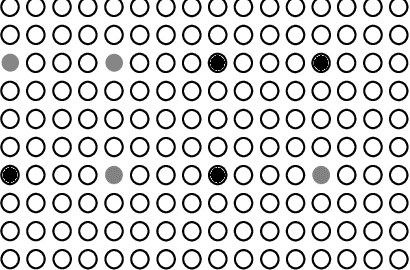
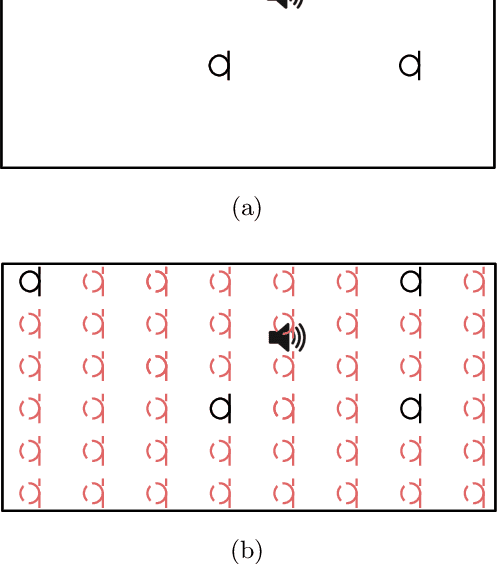
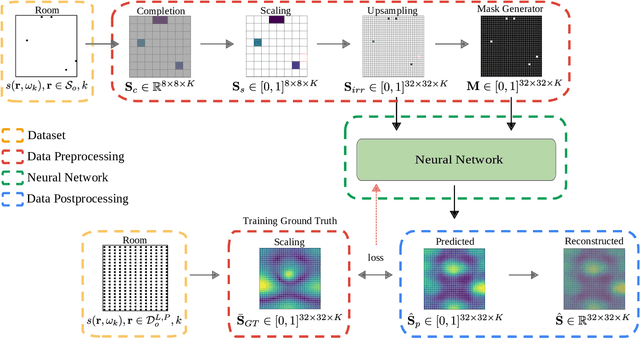
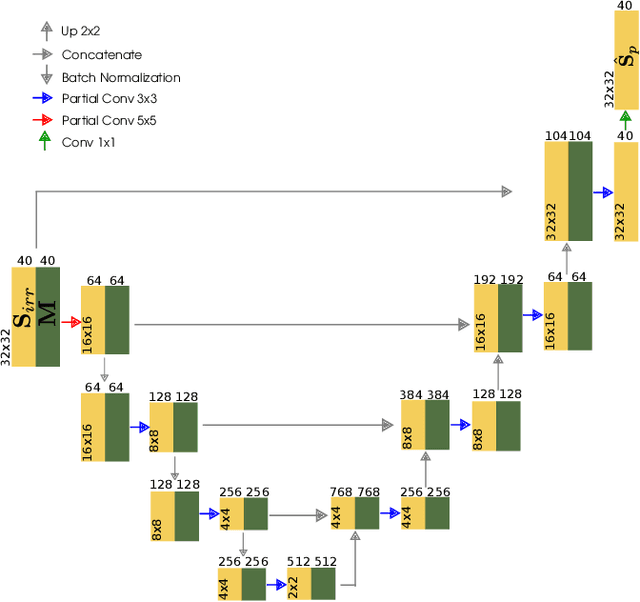
Abstract:In this paper a deep-learning-based method for sound field reconstruction is proposed. It is shown the possibility to reconstruct the magnitude of the sound pressure in the frequency band 30-300 Hz for an entire room by using a very low number of irregularly distributed microphones arbitrarily arranged. In particular, the presented approach uses a limited number of arbitrary discrete measurements of the magnitude of the sound field pressure in order to extrapolate this field to a higher-resolution grid of discrete points in space with a low computational complexity. The method is based on a U-net-like neural network with partial convolutions trained solely on simulated data, i.e. the dataset is constructed from numerical simulations of the Green's function across thousands of common rectangular rooms. Although extensible to three dimensions, the method focuses on reconstructing a two-dimensional plane of the room from measurements of the three-dimensional sound field. Experiments using simulated data together with an experimental validation in a real listening room are shown. The results suggest a performance---in terms of mean squared error and structural similarity---which may exceed conventional reconstruction techniques for a low number of microphones and computational requirements.
End-to-end music source separation: is it possible in the waveform domain?
Oct 29, 2018



Abstract:Most of the currently successful source separation techniques use the magnitude spectrogram as input, and are therefore by default omitting part of the signal: the phase. In order to avoid omitting potentially useful information, we study the viability of using end-to-end models for music source separation. By operating directly over the waveform, these models take into account all the information available in the raw audio signal, including the phase. Our results show that waveform-based models can outperform a recent spectrogram-based deep learning model. Namely, a novel Wavenet-based model we propose and Wave-U-Net can outperform DeepConvSep, a spectrogram-based deep learning model. This suggests that end-to-end learning has a great potential for the problem of music source separation.
 Add to Chrome
Add to Chrome Add to Firefox
Add to Firefox Add to Edge
Add to Edge